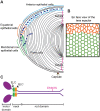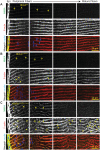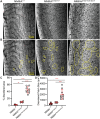Nonmuscle Myosin IIA Regulates the Precise Alignment of Hexagonal Eye Lens Epithelial Cells During Fiber Cell Formation and Differentiation
- PMID: 37070941
- PMCID: PMC10123325
- DOI: 10.1167/iovs.64.4.20
Nonmuscle Myosin IIA Regulates the Precise Alignment of Hexagonal Eye Lens Epithelial Cells During Fiber Cell Formation and Differentiation
Abstract
Purpose: Epithelial cells in the equatorial region of the ocular lens undergo a remarkable transition from randomly packed cells into precisely aligned and hexagon-shaped cells organized into meridional rows. We investigated the function of nonmuscle myosin IIA (encoded by Myh9) in regulating equatorial epithelial cell alignment to form meridional rows during secondary fiber cell morphogenesis.
Methods: We used genetic knock-in mice to study a common human Myh9 mutation, E1841K, in the rod domain. The E1841K mutation disrupts bipolar filament assembly. Lens shape, clarity, and stiffness were evaluated, and Western blots were used to determine the level of normal and mutant myosins. Cryosections and lens whole mounts were stained and imaged by confocal microscopy to investigate cell shape and organization.
Results: We observed no obvious changes in lens size, shape, and biomechanical properties (stiffness and resilience) between the control and nonmuscle myosin IIA-E1841K mutant mice at 2 months of age. Surprisingly, we found misalignment and disorder of fiber cells in heterozygous and homozygous mutant lenses. Further analysis revealed misshapen equatorial epithelial cells that cause disorientation of the meridional rows before fiber cell differentiation in homozygous mutant lenses.
Conclusions: Our data indicate that nonmuscle myosin IIA bipolar filament assembly is required for the precise alignment of the meridional rows at the lens equator and that the organization of lens fiber cells depends on the proper patterning of meridional row epithelial cells. These data also suggest that lens fiber cell organization and a hexagonal shape are not required for normal lens size, shape transparency, or biomechanical properties.
Conflict of interest statement
Disclosure:
Figures








Similar articles
-
Disease-related non-muscle myosin IIA D1424N rod domain mutation, but not R702C motor domain mutation, disrupts mouse ocular lens fiber cell alignment and hexagonal packing.Cytoskeleton (Hoboken). 2024 Dec;81(12):789-805. doi: 10.1002/cm.21853. Epub 2024 Mar 22. Cytoskeleton (Hoboken). 2024. PMID: 38516850
-
EphA2 and Src regulate equatorial cell morphogenesis during lens development.Development. 2013 Oct;140(20):4237-45. doi: 10.1242/dev.100727. Epub 2013 Sep 11. Development. 2013. PMID: 24026120 Free PMC article.
-
Non-muscle Myosin IIA (NMIIA) regulates anisotropic cell tension to maintain the hexagonal packing of mouse lens meridional row cells.Mol Biol Cell. 2025 Aug 20:mbcE25040154. doi: 10.1091/mbc.E25-04-0154. Online ahead of print. Mol Biol Cell. 2025. PMID: 40833808
-
Cataract mutations and lens development.Prog Retin Eye Res. 1999 Mar;18(2):235-67. doi: 10.1016/s1350-9462(98)00018-4. Prog Retin Eye Res. 1999. PMID: 9932285 Review.
-
Intrinsic and extrinsic regulatory mechanisms are required to form and maintain a lens of the correct size and shape.Exp Eye Res. 2017 Mar;156:34-40. doi: 10.1016/j.exer.2016.04.009. Epub 2016 Apr 21. Exp Eye Res. 2017. PMID: 27109030 Free PMC article. Review.
Cited by
-
Exploring the nexus between MYH9 and tumors: novel insights and new therapeutic opportunities.Front Cell Dev Biol. 2024 Aug 1;12:1421763. doi: 10.3389/fcell.2024.1421763. eCollection 2024. Front Cell Dev Biol. 2024. PMID: 39149512 Free PMC article. Review.
-
Disease-related non-muscle myosin IIA D1424N rod domain mutation, but not R702C motor domain mutation, disrupts mouse ocular lens fiber cell alignment and hexagonal packing.Cytoskeleton (Hoboken). 2024 Dec;81(12):789-805. doi: 10.1002/cm.21853. Epub 2024 Mar 22. Cytoskeleton (Hoboken). 2024. PMID: 38516850
-
Tissue, cellular, and molecular level determinants for eye lens stiffness and elasticity.Front Ophthalmol (Lausanne). 2024 Aug 8;4:1456474. doi: 10.3389/fopht.2024.1456474. eCollection 2024. Front Ophthalmol (Lausanne). 2024. PMID: 39176256 Free PMC article. Review.
-
Whole Mount Imaging to Visualize and Quantify Peripheral Lens Structure, Cell Morphology, and Organization.J Vis Exp. 2024 Jan 19;(203):10.3791/66017. doi: 10.3791/66017. J Vis Exp. 2024. PMID: 38314859 Free PMC article.
References
-
- Lovicu F, Robinson M. Development of the ocular lens. Cambridge, UK: Cambridge University Press; 2004.
-
- Lovicu F, Robinson M. Development of the ocular lens. Cambridge, UK: Cambridge University Press; 2004.
Publication types
MeSH terms
Substances
Grants and funding
LinkOut - more resources
Full Text Sources
Molecular Biology Databases
Miscellaneous

